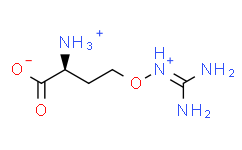L-Canavanine sulfate (L-CAV) causes only a limited degree of cytotoxicity in HeLa, Hep G2, and SK-HEP-1 cells when given alone in arginine-rich media with IC50 values ranging from 5 to 10 mM. In HaCaT keratinocyte cell line, IC50 of L-Canavanine sulfate exceeds the concentration of 10 mM, indicating low cytotoxicity in normal cells 体外研究. In arginine-free media, IC50 of L-Canavanine sulfate in HeLa, Hep G2, and SK-HEP-1 cells are 0.21±0.04; 0.64±0.16; and 1.18±0.14 mM, respectively. L-Canavanine sulfate, which is hardly toxic alone, potentiates the cytotoxicity of vinblastine (VIN) and paclitaxel (PTX) in HeLa and hepatocellular carcinoma cells.
Medlife has not independently confirmed the accuracy of these methods. They are for reference only.



 扫码关注公众号
扫码关注公众号